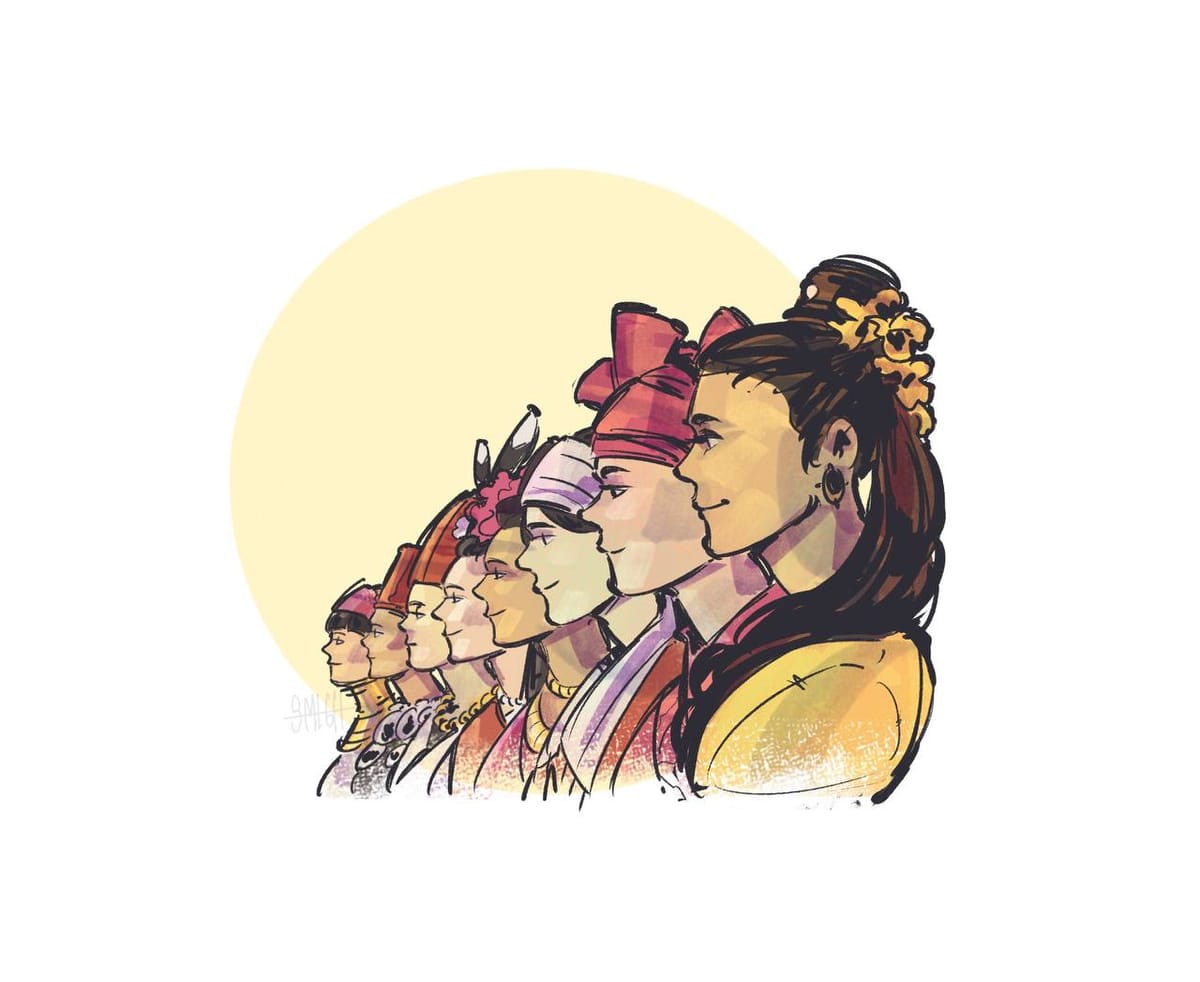
Myanmar is a country where diverse ethnic groups coexist harmoniously. Throughout the nation, you can find different ethnicities and their distinct cultures. This article will help you understand the fundamental aspects of these groups, including their regional environments, historical backgrounds, religious beliefs, and languages.
According to government records, Myanmar has 8 major ethnic groups. These major ethnic groups are further divided into 135 distinct ethnic subgroups. The eight major ethnic groups are Kachin, Kayah, Karen, Chin, Mon, Bamar, Rakhine, and Shan. Here's how these groups break down:
- Kachin: 12 ethnic subgroups
- Kayah: 9 ethnic subgroups
- Karen: 11 ethnic subgroups
- Chin: 53 ethnic subgroups
- Bamar: 9 ethnic subgroups
- Mon: 1 ethnic group
- Rakhine: 7 ethnic subgroups
- Shan: 33 ethnic subgroups
Let's explore each of these major ethnic groups in detail.
Kachin
Historical Background
The Kachin people are descendants of the Tibeto-Burman family, sharing ancestral roots with the Bamar people. The Tibeto-Burman groups entered northern Myanmar in the 11th century and reached the interior of Kachin State by the 15th century. The Kachin comprise 12 subgroups: Kachin, Taron, Dalaung, Jinghpaw, Gauri, Khaku, Duleng, Maru (Lawgore), Rawang, Lashi, Atsi, and Lisu.
Religion
Most Kachin people were traditionally animists. After the arrival of Christian missionaries around 1856, many converted to Christianity. Today, while there is a growing Buddhist population, the majority remain Christian.
Language and Literature
Initially, the Kachin people had spoken language but no written script. Christian missionaries developed their written language using Roman letters.
Festivals
The most prominent Kachin festival is the Manaw Festival. The New Harvest Festival is another significant celebration.
Notable Figures
Some prominent Kachin individuals include Sama Duwa Sinwa Nawng (who signed the Panglong Agreement), U Ti Khun Myat (former Speaker of the Pyidaungsu Hluttaw), Aung La N Sang (MMA fighter), General N'Ban La (former KIA/KIO Chairman), and Lahpai Seng Raw (Ramon Magsaysay Award recipient).
Kayah
Historical Background
According to linguistic studies, the Kayah people are also of Tibeto-Burman descent. They migrated to Myanmar from the north over 1,000 years ago. During the British period, they were known as Karenni (Red Karen) due to their traditional red clothing. The Kayah have 9 subgroups: Kayah, Zayein, Kayen (Padaung), Gekho, Gebar, Pre (Kayaw), Manu Manaw, Yintale, and Yinbaw.
Religion
The Kayah were traditionally animists, with totem poles playing a significant role in their worship. Later, many converted to Christianity, while a significant number also practice Buddhism.
Language and Literature
The Kayah people have their distinct language, known as Kayah.
Festivals
Notable Kayah festivals include the Frog Drum Festival, Kay Htoe Boe Festival, Totem Pole Festival, and various traditional dances like the Dee Khu, House-warming ceremony dance, and bamboo dance.
Notable Figures
Notable Kayah individuals include Sao Phar Phoe and Kayah U Sein.
[Content continues with detailed sections for Karen, Chin, Bamar, Mon, Rakhine, and Shan ethnic groups...]
Karen
Historical Background
The Karen people, like other Tibeto-Burman ethnicities, entered Myanmar through the Thanlwin (Salween) River route from the northeast. Researchers note that they settled in the western Shan plateau, with some moving to the plains and others to the highlands. Karen people are often categorized as Pwo Karen (highlanders) and Sgaw Karen (lowlanders). There are 11 Karen subgroups: Karen, White Karen, Paku, Mon Karen (Sa Phyu), Sgaw Karen, Talaepwa, Paku, Bwe, Monae Pwa, Moe Pwa, and Pwo Karen.
Religion
Karen people traditionally practiced animism, also known as spirit worship. They believed in chicken bone divination. Today, most are Buddhists, while many converted to Christianity during the British colonial period when missionaries arrived in Karen territories.
Language and Literature
The Karen have their own language. According to Professor G.H. Luce, who mastered ancient hill Karen dialects, the Karen are Tibeto-Burman language speakers.
In 1830, during the British period, Dr. Wade, an American Baptist missionary, developed a written script for Sgaw Karen using Burmese characters to spread Christian teachings. This led to the creation of the Sgaw Karen Bible. In 1841, Dr. Mason, an American missionary, began publishing a Karen newspaper, which continued for about 100 years until the Japanese invasion. The Pwo Karen script was developed around 1840 by Mr. Brayton.
Festivals
Significant Karen festivals include the New Rice Festival, Karen New Year, Bone Collection Festival, and the traditional Karen Wrist-Tying Ceremony.
Notable Figures
The Karen are known for their honesty and bravery. Notable Karen individuals include nationalist leader Mann Ba Khaing, Myanmar's third President Mann Win Maung, Defense Forces Chief of Staff General Smith Dun, Iron Cross band founder Saw Bwe Mhu, and famous lead guitarist Chit San Maung.
[Content continues with remaining ethnic groups...]
Summary
These eight major ethnic groups and their 135 subgroups make Myanmar a nation rich in diversity. The country is characterized by various ethnic groups living together with their unique cultures and national identities.
Understanding each other's ethnic backgrounds helps build trust and contributes to creating a harmonious nation where different communities can thrive together.
Han Thit Ein (Y3A)
Read More:
 Build Myanmar - MediaY3A
Build Myanmar - MediaY3A
 Build Myanmar - MediaBuild Myanmar Staff
Build Myanmar - MediaBuild Myanmar Staff
Build Myanmar-Media : Insights | Empowering Myanmar Youth, Culture, and Innovation
Build Myanmar-Media Insights brings you in-depth articles that cover the intersection of Myanmar’s rich culture, youth empowerment, and the latest developments in technology and business.
Sign up for Build Myanmar - Media
Myanmar's leading Media Brand focusing on rebuilding Myanmar. We cover emerging tech, youth development and market insights.
No spam. Unsubscribe anytime.
Sign up now to get the latest insights directly to your mailbox from the Myanmar's No.1 Tech and Business media source.
📅 New content every week, featuring stories that connect Myanmar’s heritage with its future.
📰 Explore more:
- Website: https://www.buildmyanmarmedia.com/
- Facebook: https://www.facebook.com/buildmyanmar
- YouTube: https://youtube.com/@buildmyanmarmedia
- Telegram: https://t.me/+6_0G6CLwrwMwZTIx
- Inquiry: info@buildmyanmar.org
#MyanmarUpdates #MyanmarNews #BuildMyanmarMedia #Myanmarliterature #myanmararticle #Updates #Insights #Media
